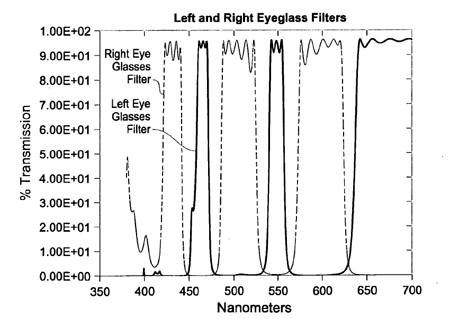If this eventually gets to the home theater projector market, while it may not require a silver screen, would it still need a high gain screen? Do you think current AT screens which max out at 1.2 gain would work?
Dolby 3D


The human visual system is sensitive to light wavelengths from about 400 to 700 nanometers (nm). And as you might know already, all color-video images are produced by combining red, green, and blue in various amounts. This works well since the retinas in our eyes contain cells that are more or less sensitive to these primary colors. However, these cells are not sensitive to only one wavelength of each color—the red-sensitive, green-sensitive, and blue-sensitive cells respond to bands of overlapping wavelengths as shown above. (In the diagram, S = short wavelength, M = medium wavelength, L = long wavelength.)
As a result, video displays can use different wavelengths of red, green, and blue to reproduce a nearly full-color image. One well-known standard is called Rec. 709, which defines the colors of red, green, and blue for HDTV; digital cinema uses a different set of RGB. (As a side note and just for the sake of completeness, the three colors in both cases are not purely monochromatic single wavelengths—each one includes a bit of the other two—but this is not important for our discussion here.)

Dolby 3D takes advantage of the fact that red, green, and blue can be defined differently to isolate the image for each eye in a stereoscopic presentation. First developed by a German company called Infitec (short for Interference Filter Technology), this solution is actually quite ingenious—project the left-eye image using one set of red, green, and blue wavelengths and the right-eye image using a slightly different set of RGB wavelengths, as depicted in the diagram above from Dolby's patent.

To see the 3D effect, viewers wear glasses with filters that allow only the appropriate set of RGB wavelengths to reach the corresponding eye. These glasses are more costly than polarized glasses but not nearly as expensive as active-shutter glasses.
The whole idea of color filtering has led some to call Dolby 3D "super anaglyph," because each eye sees different colors. However, I think this characterization is misleading—anaglyph most commonly refers to those dreadful red-and-blue glasses that yield a very poor 3D image. I've seen Dolby 3D, and the experience is nothing like traditional anaglyph.

Of course, the two color gamuts are slightly different, as depicted in the CIE diagram above, also from Dolby's patent. As you can see, the left-eye color gamut (incorrectly labeled "color space" in the diagram) is slightly more saturated than the right-eye gamut, but the white points are nearly coincident. (BTW, the numbers labeling the white points in the diagram are patent-reference numbers and have nothing to do with any technical aspect of these points.)
To show Dolby 3D, a digital-cinema projector is equipped with a filter wheel, as depicted at the top of this blog, much like the color-filter wheel in single-chip DLP projectors. In this case, however, the wheel is divided in half—one half filters the light from the projector's lamp into one set of RGB wavelengths and the other half filters the light into the other set of wavelengths. The projector is synchronized to display the left or right image when the appropriate filter is in position.
The main advantage of Dolby 3D over polarized 3D is that no special silver screen is required. This results in greater color accuracy for both 2D and 3D presentations by avoiding the color shifts introduced by polarization-preserving silver screens.
To date, Dolby has shipped about 3700 Dolby 3D systems to commercial theaters worldwide (925 of which are in the US); to find one near you, click here. However, there are no consumer projectors that use this technology—yet. I don't doubt that Dolby is working on this, and I hope to see a consumer version soon, if only so that one screen can be used to display the best possible image in both 2D and passive 3D.
- Log in or register to post comments

Like all 3D glasses, these reduce the amount of light reaching the eyes, so some gain would probably be a good thing. Stewart specifies a gain of 1.3 to 1.5 for active-shutter glasses, which reduce the light more than either polarized or Dolby 3D glasses, so I would think that a gain of 1.2 or 1.3 (as with the Studiotek 130, a very common material for home theaters) should be fine.

Scott, in your opinion, is the Dolby 3D technology superior to that used in filming Avatar. I may be wrong but I think special high dollar Panasonic cameras were used in making that movie. How do the two technologies differ? Also, you mentioned that the commercial projectors that use Dolby 3D will use a filter wheel similar in concept to the color wheel used in single chip DLPs. Does the use of these filter wheels have potential to introduce unwanted artifacts like the rainbow effect some are sensitive to.

Great article! I assumed that RealD3D and Dolby 3D were two of the same technology but it goes to show what I know. I especially liked the small diagram at the top showing the inner-workings of a Dolby 3D projector. I just viewed Shrek IV at the theater in Dolby 3D and it was fantastic! For me, the glasses worn for RealD3D are more comfortable than the Dolby 3D glasses tho. My hometown has a RealD3D theater and about an hour away is a Warren Theater with a Dolby 3D set-up. I have been watching the same movie in each theater for comparison; Shrek IV 3D being the most recent. The main difference I can see is that the RealD3D was brighter than Dolby 3D. If I had to guess, I would say the difference is calibration related. Scott, do you know if when a theater purchases a Dolby 3D or RealD3D setup, is it installed and calibrated by the manufacturer or does the theater have to hire an installer? Thanks

K, the processes of capturing 3D and displaying 3D are completely independent of each other. Live-action 3D is captured with special cameras, and 3D animation is generated within computers. That information can then be displayed in several different ways, one of which is Dolby 3D. Good question about the filter wheel and rainbow-like artifacts. I haven't seen this myself, but I don't know for sure. I suspect it's not a problem for Dolby 3D, since the difference in color is very subtle, not pronounced like the difference between red, green, and blue in a DLP filter wheel.

Jarod, I just wrote about seeing Shrek 4 in Imax 3D here: http://blog.ultimateavmag.com/scottwilkinson/bigger_is_better/ The difference in brightness you cite could involve several factors, including the specific projectors, screen size and gain, and calibration. I don't know if the technology providers typically calibrate the systems; I'll try to find out.

Regarding possible color-wheel artifacts with Dolby 3D sysems: I've done LOTS of reading on numerous fora about consumers' perceptions of the various in-theater 3D-presentation technologies, and this question (among many others!) always has been in my mind. (Aside: The question resonates, as I'm sensitive to rainbow artifacts from consumer DLP machines, particularly older models with slower color wheels--mea culpa, I admit that my early experiences have tainted my feelings about DLP, and I've not been especially keen to audition newer models; similarly, this bias may also subconsciously have hindered my desire to audition Dolby 3D). In any event, I proposed to give the time, but am telling you how to build a watch; the short of it is, I have not seen ANY mention of effects similar to rainbow sensitivity. Of course, this is no negative proof. But, intellectually, without having seen a Dolby 3D movie, I believe Scott must be right about the subtlety of the process. I'm hopin'.


















































